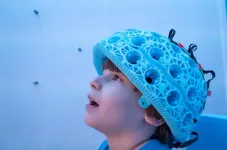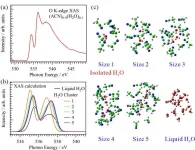(Press-News.org) May 30, 2024, Leiden, The Netherlands - A 3D model of imitation blood vessels will make it possible to see exactly how snake venom attacks blood vessels, without having to use laboratory animals. This new research model, called an organ-on-a-chip, was developed by a research team from Vrije Universiteit Amsterdam, MIMETAS and Naturalis Biodiversity Center.
Roughly one hundred thousand people die annually from the effects of a snake bite and four times as many sustain chronic injuries. Research into how snake venom works is needed to arrive at a solution, but remains difficult to implement. A research team from the Vrije Universiteit Amsterdam (VU), MIMETAS and Naturalis Biodiversity Center, has now proven for the first time that snake venom can be examined on 3D imitation blood vessels.
Organ-on-a-chip
This new approach to 3D imitation blood vessels improves on traditional research methods, such as using laboratory animals or cell cultures, by mimicking human blood vessels. “The advantage of such a blood vessel model for venom research is that it takes into account several important influences that the body faces,” explains venom expert and first author of the study, Mátyás Bittenbinder of VU and Naturalis. “Like the flow of blood, or the construction and shape of a blood vessel.”
The 3D blood vessel model, called MIMETAS' OrganoReady® Blood Vessel HUVEC, thus contributes to better understanding the damaging effects of snake venom on blood vessels and the rest of the body. “The model provides accurate insight into how toxins attack blood vessels. This knowledge will help us develop better methods to treat snake bites, while also reducing the need to do studies on mice,” says Bittenbinder.
Effect of venom
The functioning of the blood vessel model was tested with the venom of an Indian cobra (Naja naja), West-African carpet viper (Echis ocellatus), many-banded krait (Bungarus multicinctus) and Mozambique spitting cobra (Naja mossambica). A bite from a venomous snake often causes severe (internal) bleeding. This is because the venom attacks the circulatory system, destroying blood vessels and creating blood clots. Worldwide, scientists are searching for a solution. “If we better understand which substances are in snake venom, we will also know better how to neutralize the toxins,” Bittenbinder explains.
Global problem
Snake bites are a humanitarian crisis that affects millions of people each year but rarely makes the news. It is estimated that between 80,000 and 140,000 people die each year from poisonous snake bites. Another 400,000 survive but become blind or lose a hand, foot, or leg as a result of a bite.
Additional information, not for publication:
This press release is embargoed until June 4, 2024, 10:00 AM UK Time.
This is a joint press release from Vrije Universiteit Amsterdam, MIMETAS, and Naturalis Biodiversity Center.
The article called ‘Bloody insights: using organ-on-chip technology to study haemorrhagic activities of snake venoms on endothelial tubules’ will be published June 4 in Springer Nature.
Supporting image and film material can be found in this press kit. Credits are in the file names; please credit them.
For substantive questions, please contact first author Mátyás Bittenbinder at matyas.bittenbinder@naturalis.nl or +316 14611808.
For general questions, please contact Naturalis' Communications & Partnerships Department at communicatie@naturalis.nl or 071 - 7519 648. Outside office hours, we can be reached for press inquiries at +316 - 35 11 29 99. END
Bloody insights: Organs-on-chip ready to help snake venom research
Fewer laboratory animals needed, thanks to imitation blood vessels
2024-06-04
ELSE PRESS RELEASES FROM THIS DATE:
Some countries could meet their total electricity needs from floating solar panels, research shows
2024-06-04
Floating solar photovoltaic panels could supply all the electricity needs of some countries, new research has shown.
The study, by researchers from Bangor and Lancaster Universities and the UK Centre for Ecology & Hydrology, aimed to calculate the global potential for deploying low-carbon floating solar arrays. The researchers calculated the daily electrical output for floating photovoltaics (FPV) on nearly 68,000 lakes and reservoirs around the world, using available climate data for each location.
The researchers’ ...
Population shifts, risk factors may triple U.S. cardiovascular disease costs by 2050
2024-06-04
Embargoed until 4 a.m. CT/5 a.m. ET Tuesday, June 4, 2024
DALLAS, June 4, 2024 — Driven by an older, more diverse population, along with a significant increase in risk factors including high blood pressure and obesity, total costs related to cardiovascular disease (CVD) conditions are likely to triple by 2050, according to projections from the American Heart Association, observing 100 years of lifesaving service as the world’s leading nonprofit organization focused on heart and brain ...
5-minute test leads to better care for people with dementia in the primary care setting
2024-06-04
June 4, 2024—(BRONX, NY)—The underdiagnosis of dementia, especially among Black and Hispanic patients, is a long-standing challenge in medicine. A new study, published today in Nature Medicine, finds that an easy, five-minute assessment paired with recommendations built into the electronic medical record system led to a three-fold improvement in diagnosis and treatment for patients in a primary care setting compared to a control group. The “5-Cog paradigm,” which was developed by researchers at Albert Einstein College of Medicine and Montefiore Health System, dramatically enhances ...
Wearable brain imaging gives clearest ever picture of children’s developing brain
2024-06-04
New research has given the clearest ever picture of young children’s developing brains, using a wearable brain scanner to map electrical brain activity. The work opens up new possibilities for tracking how critical developmental milestones, like walking and talking, are underpinned by changing brain function, and how neurodevelopmental conditions like autism emerge.
The research team, led by scientists from the University of Nottingham’s School of Physics and Astronomy, used a novel design of magnetoencephalography ...
Taking care of caregivers of children with ADHD
2024-06-04
Attention deficit hyperactivity disorder (ADHD) is a common neurodevelopmental disorder characterized by elevated levels of inattention, impulsivity, and hyperactivity that can impair academic and social functioning. ADHD is also associated with increased levels of parenting stress, less effective parenting practices, and can disrupt the parent-child relationship. The importance of support for parents of children with ADHD is widely acknowledged in Japan, but specialized parent training programs targeting ADHD have not been available.
However, a new program developed at the Okinawa Institute of Science and Technology (OIST) aims to reduce the strain on families ...
Florida infection preventionist successfully advocates for staff growth, keeping pace with hospital’s expanding service lines
2024-06-04
San Antonio, Texas, June 4, 2024 – In an era of hospital budget cuts and staffing freezes, a Florida hospital more than doubled staff positions for infection prevention and control (IPC) over a four-year period, reducing infections and creating opportunities for non-clinical team members to enter the field and excel.
By presenting a business case showing costs of excess healthcare-associated infections (HAIs), infection preventionist (IP) Luz Caicedo, MPH, CPH, CIC, CRCST, VA-BC at AdventHealth in Celebration, Florida was able to increase IPC staff from 2 to 4.8 ...
Surgical site infection rates and other secondary outcomes decrease dramatically at multi-state hospital system through standardized, preoperative, surgical, antibiotic practices
2024-06-04
San Antonio, Texas, June 4, 2024 – Mortality, length of stay, readmissions, and surgical site infections (SSI) all declined after a six-state hospital system implemented a comprehensive surgical site infection (SSI) prevention bundle, according to a report presented today at the 2024 APIC Annual Conference.
Banner Health, which operates facilities in Arizona, California, Colorado, Nebraska, Nevada, and Wyoming, reported on the impact of a surgical antimicrobial prophylaxis (SAP) bundle on more than 57,000 surgical cases from January 2019 to December 2023. Four publicly reportable procedures ...
Videoconferencing gets older adults moving as health lessons put to practical use
2024-06-04
The COVID-19 pandemic made videoconferencing software commonplace in businesses and even schools, but this communication tool has the potential to offer benefits beyond the office or classroom. An Osaka Metropolitan University-led research team has been exploring how videoconferencing can improve the health of older adults living in the countryside.
OMU Associate Professor Kazuki Uemura of the Graduate School of Rehabilitation Science and colleagues devised a 12-week health education program conducted using the videoconferencing software Zoom, with the aim of having participants engage in active learning. A control group was provided a similar 12-week ...
The importance of a disturbed lipid metabolism in Charcot-Marie-Tooth disease
2024-06-04
Leuven, 4 June 2024 - Charcot-Marie-Tooth disease (CMT), a group of heritable disorders that affect the peripheral nerves, is marked by specific genetic changes. Research by the team of Prof. Ludo Van Den Bosch (VIB-KU Leuven) now reveals the effects of one such genetic cause. They found that the duplication of the gene PMP22 causes problems in the cell membrane of Schwann cells that provide the insulating cover for nerves. The results appeared in the journal Brain.
Gene duplication in CMT1A
Charcot-Marie-Tooth disease is a group of inherited disorders ...
Soft X-ray absorption spectroscopy analysis of isolated water molecules within aqueous acetonitrile solutions
2024-06-04
Herein, the O K-edge X-ray absorption spectroscopy (XAS) profile of an aqueous acetonitrile solution presented a distinct sharp peak not commonly observed in the corresponding profile of liquid water. Inner-shell calculations coupled with molecular dynamics simulations revealed that this sharp peak originated from isolated water molecules surrounded by acetonitrile molecules, rather than from water clusters. Hence, O K-edge XAS could facilitate the electronic-structural analysis of isolated water molecules, differentiating their contributions ...
LAST 30 PRESS RELEASES:
Why swearing makes you stronger
What prevents more cancer patients from enrolling in potentially life-saving clinical trials?
UK’s worst-case climate risks laid bare for lawmakers
A decline in churchgoing linked to more deaths of despair
TAMEST announces Maralice Conacci-Sorrell, Ph.D., UT Southwestern Medical Center, as 2026 Mary Beth Maddox Award & Lectureship Recipient
Global study to evaluate whether dengue outbreaks can be anticipated earlier
Chonnam National University researchers propose innovative voltage-loop control for power factor correction
Accelerating next-generation drug discovery with click-based construction of PROTACs
Detecting the hidden magnetism of altermagnets
$7M gift supports health research, engineering and athletics at UT San Antonio
NU-9 halts Alzheimer’s disease in animal model before symptoms begin
Hospitals acquired by real estate investment trusts associated with greater risk of bankruptcy, closure
City of Hope scientists study rare disorder to uncover mechanism and hormone regulation underlying fatty liver disease and sweet aversion
Your genes may influence gut microbiome of others, rat study shows
‘Personality test’ shows how AI chatbots mimic human traits – and how they can be manipulated
Global food systems driving twin crises of obesity and global heating
Osaka Medical and Pharmaceutical University researchers capture real-time molecular movies of enzyme catalysis
Could your genes influence the gut microbiome of others?
Clues to Alzheimer’s disease may be hiding in our ‘junk’ DNA
Study reveals that the body uses different sensors to detect cold in the skin and in internal organs
iPS cells from dish to freezer and back
Deep neural networks enable accurate pricing of American options under stochastic volatility
Collective risk resonance in Chinese stock sectors uncovered through higher-order network analysis
Does CPU impact systemic risk contributions of Chinese sectors? Evidence from mixed frequency methods with asymmetric tail long memory
General intelligence framework to predict virus adaptation based on a genome language model
Antibiotic resistance is ancient, ecological, and deeply connected to human activity, new review shows
Vapes, pouches, heated tobacco, shisha, cigarettes: nicotine in all forms is toxic to the heart and blood vessels
From powder to planet: University of Modena engineers forge a low-carbon future for advanced metal manufacturing
Super strain-resistant superconductors
Pre-school health programme does not improve children’s diet or physical activity, prompting call for policy changes, study finds
[Press-News.org] Bloody insights: Organs-on-chip ready to help snake venom researchFewer laboratory animals needed, thanks to imitation blood vessels









